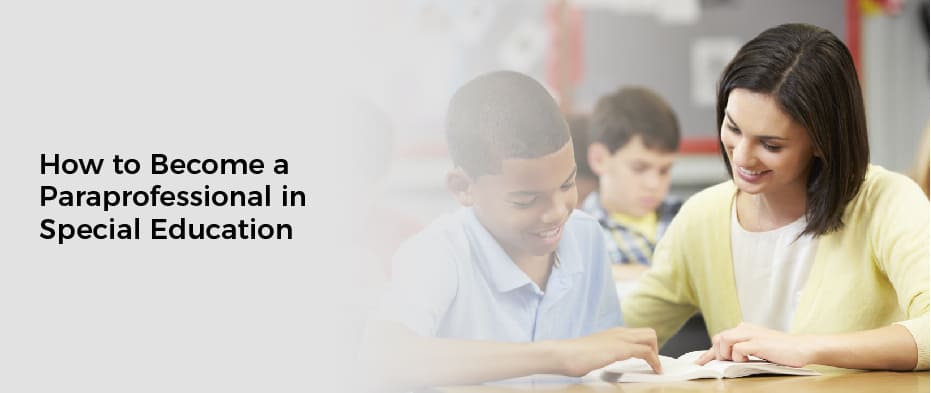
How to Become a Paraprofessional in Special Education
Table of Contents
Becoming a paraprofessional is an excellent way to gain experience in the education field and help students reach their full potential. As you work alongside teachers, administrators, and other professionals, you will gain valuable skills that can be used in your future career aspirations.
This guide outlines steps to becoming a para-professional, including education and experience requirements, job duties, and ways to stand out from the competition. By carefully considering these factors, you will have a better chance of becoming a successful para-professional.
What Is Paraprofessional?
A paraprofessional’s responsibilities vary depending on the setting or area in which they work. In addition to helping lesson plans run smoothly, they work with students and learning goals.
A paraprofessional is a specially trained, credentialed educational worker who supports students in school under the supervision certified or licensed by a teacher. Your child may notice this type of aide in their classroom or be assigned to individually engage with a para-professional as part of an Individualized Education Plan (IEP).
They are not only found in special education. But schools use them often in this field—these professionals support a general or special education teacher with multiple tasks in the classroom.
1. Behavioral Support Paraprofessional
Para-professional students often have a behavior intervention plan (BIP) that these professionals can help tool when they feel agitated.
BIPs reward good behavior through a written improvement plan – they are any bad behavior or punishments for children whose behavior interferes with learning.
Behavior support paraprofessionals often form strong connections since they work closely with the student they support. Because of this, they can help the student’s teacher understand what the student wants to communicate through their misbehavior.
2. Physical Assistance Paraprofessional
When the child isn’t physically active in the classroom, they may need physical support, and a para-professional assists them. This para-professional may assist the student with feeding, using the bathroom, and getting around campus.
Therefore, they can assist the teacher in understanding what the student is trying to communicate through their misbehavior. There will be some students who have a physical disability. A paraprofessional may support a student with their adaptive skills depending on the severity of their disability, which may include: communicating with the student, helping them move around the classroom, or providing personal care.
In order to work as a para-professional, you may need certain certifications and licenses in your state. These could include first aid or CPR certification, special education certification, or health-related coursework.
3. Special Education Paraprofessional
A special education teacher should provide para-professional instruction, guidance, and strategies when a student has behavioral needs.
The average special education paraprofessional works in five weekly classes and serves 21 students, 15 of whom have disabilities. However, 15 percent of all students served by paraprofessionals are limited English proficient, and 31% are fluent or nearly fluent in the non-English language spoken by their students.
What Do Paraprofessionals Do?
The majority of special education paraprofessionals spend at least 10% of their time on each of the following activities:
- Providing personal care assistance.
- Providing one-on-one instruction.
- Meeting with teachers.
- Modifying materials.
Paraprofessionals are workers who do not hold a bachelor’s degree but have taken the basic courses for that field. Paraprofessionals are commonly found in the field of health and education departments. They have a good teaching assistant that can make a big difference in the classroom.
Even more, if they are enthusiastic, they use strategies that encourage student behavior and increase their focus on their goals. Paraprofessionals often do not work directly in schools but in the school district, mental health agencies, early childhood programs, or some follow-up agency for students after graduation.
How Many Percents Do You Have To Be Educated For Paraprofessionals?
- High school diploma or less (29%).
- Some colleges (38%).
- Associate’s degree or higher (32%).
How Do I Become A Paraprofessional?
Paraprofessionals have required to have a high school diploma or its equivalent.
- I finished two years of study at a college, university, or technical school.
- Take at least an associate degree.
- High School Diploma or Equivalency and Passing score on ACT Work Keys Test OR Passing score on ETS ParaPro Test.
Approximately 13% have a paraprofessional certificate or credential. Another 6% have a teaching certificate or license.
It is possible to prove this through a formal academic assessment administered by the state or local government. In addition, you will have to ask each district about this because different districts might also require complete para-professional training.
If you have a high school diploma or equivalency, you will need to take the paraprofessional assessment and pass the course or diploma.
Approximately 33% of paraprofessionals had to complete learning hours. 76% received training in teaching academic concepts and skills, and 83% received training in implementing behavior management programs designed by district teachers.
Many educated paraprofessionals in this field spend far more time in professional development, which may increase differences in levels of skill.